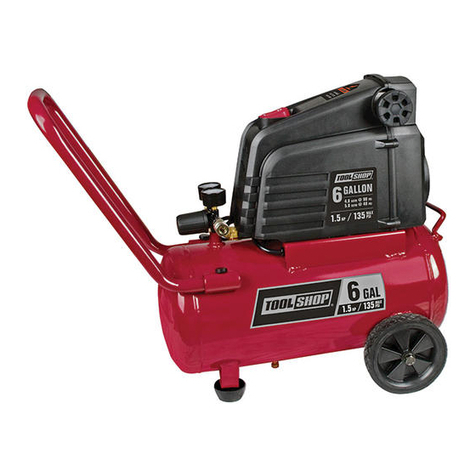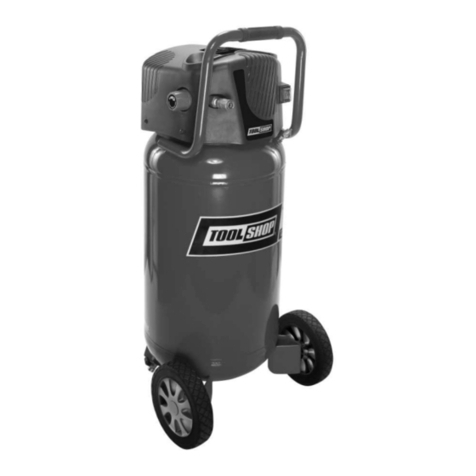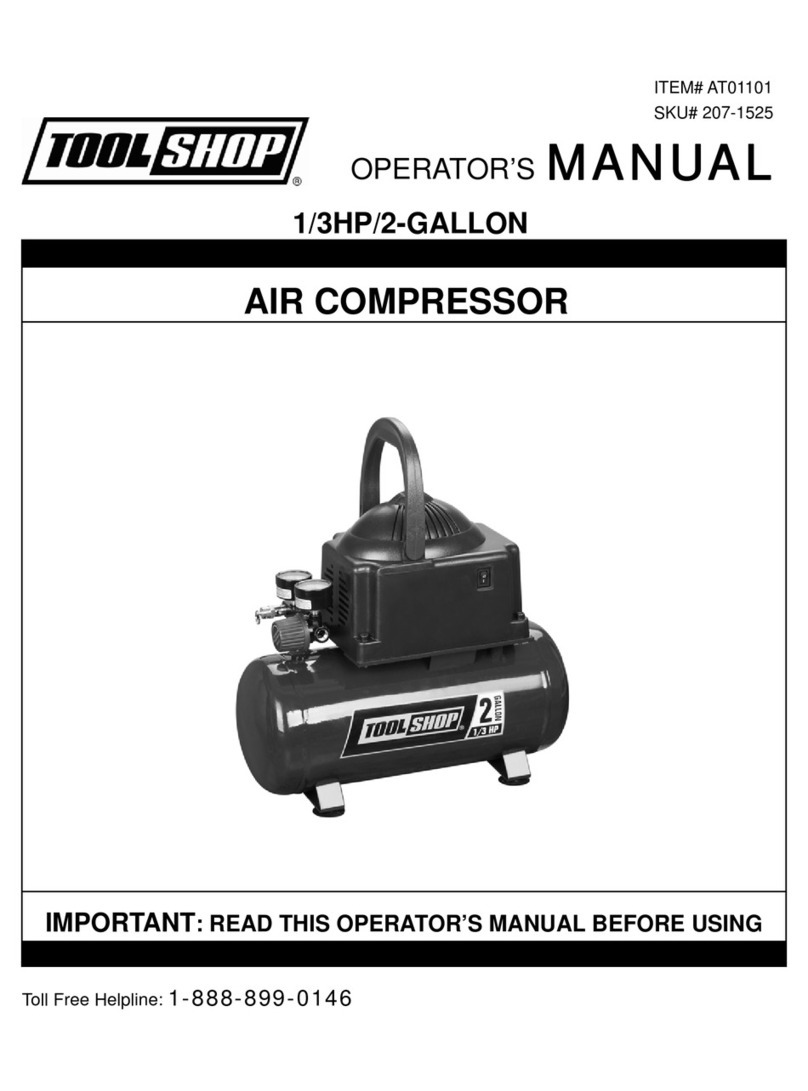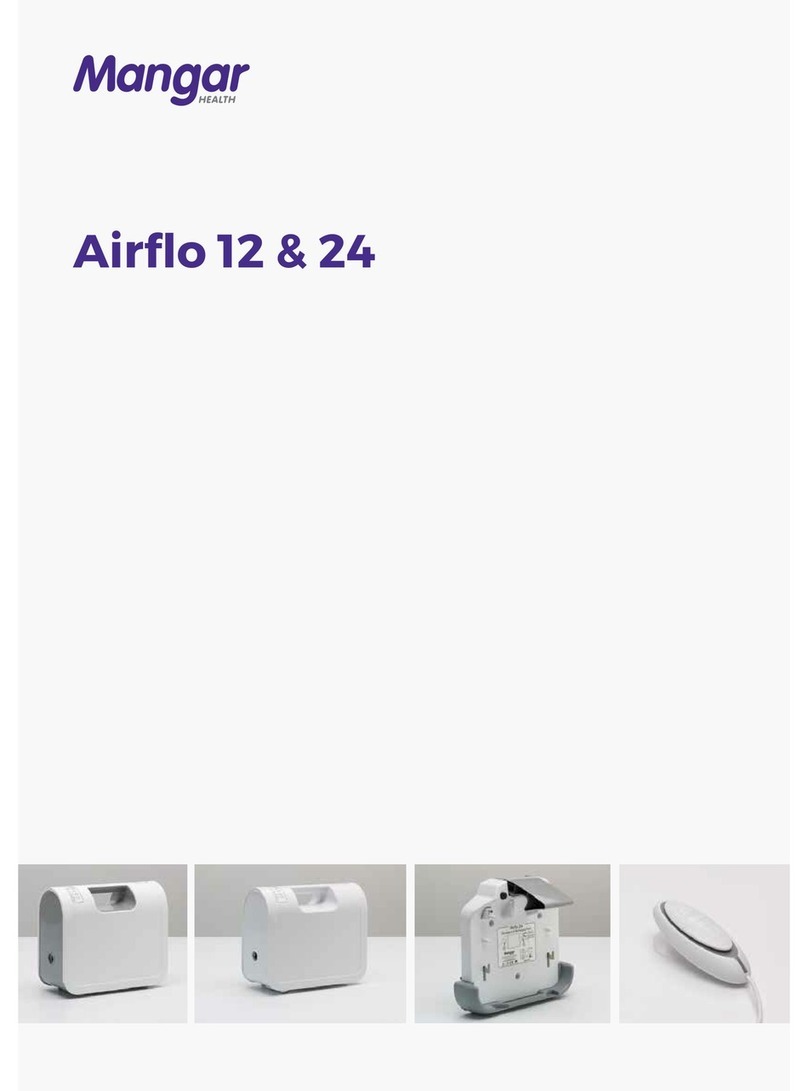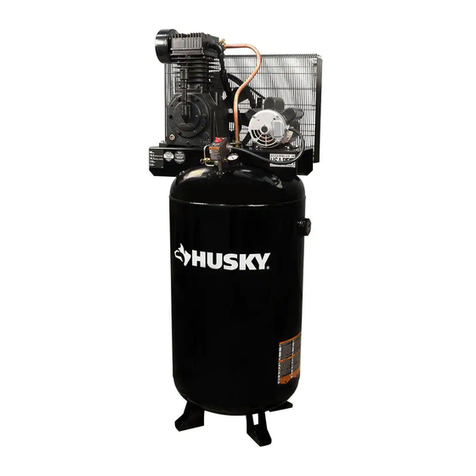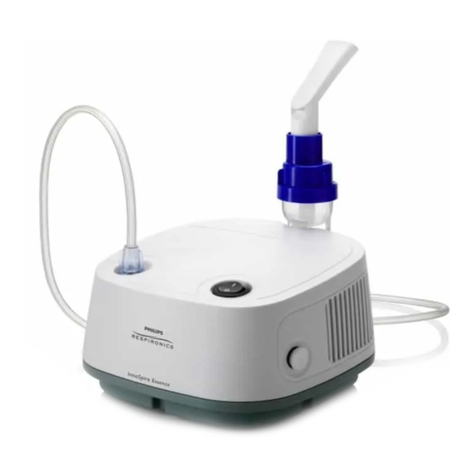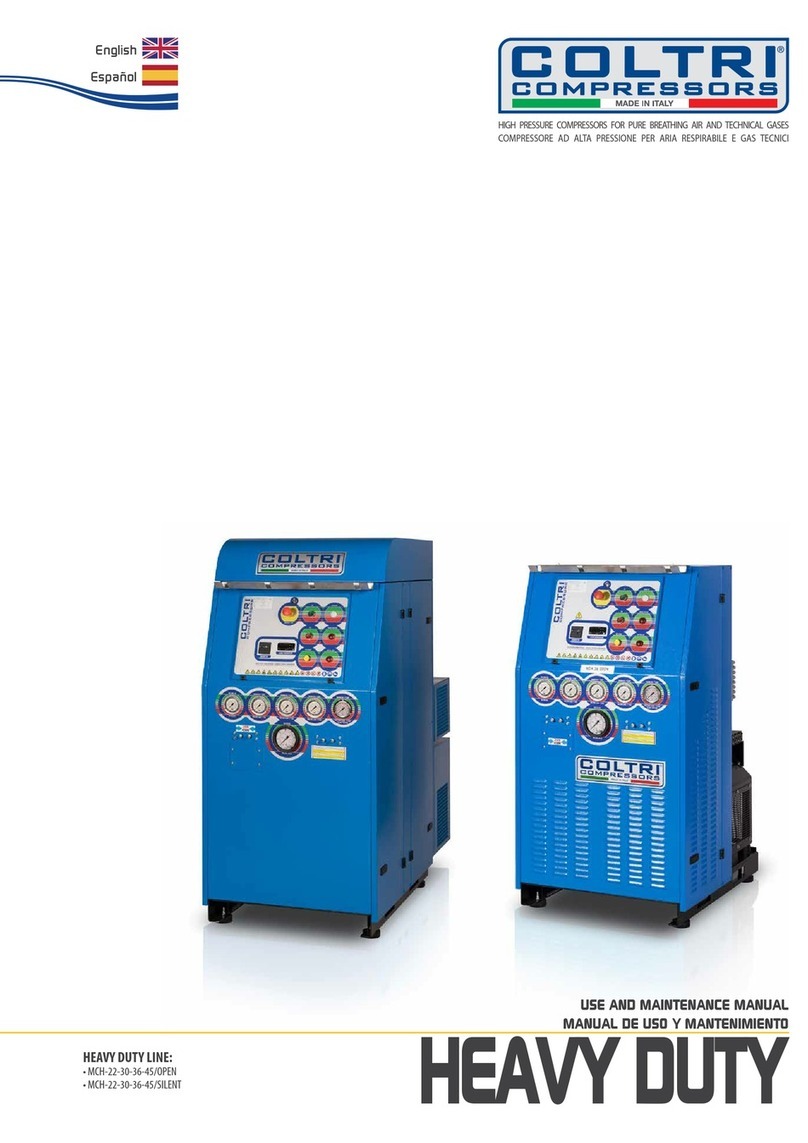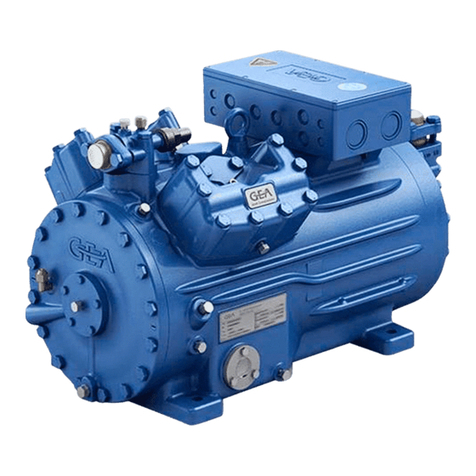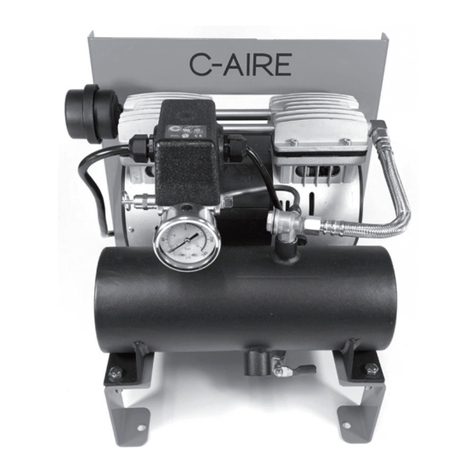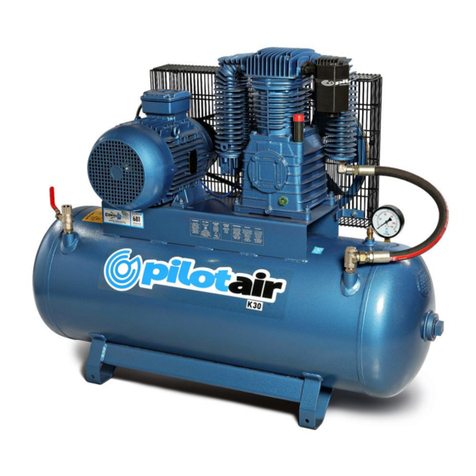Toolshop AT01101 User manual

OPERATOR’S MANUAL
ITEM# AT01101
SKU# 207-1526
Toll Free Helpline: 1-888-899-0146
E-Mail: info@altonindustries.com

SAFETY GUIDELINES------------------------------------------------------------------------------------3
BASIC COMPRESSOR FEATURES-------------------------------------------------------------------------4
ELECTRIC MOTOR & AIR COMPRESSOR PUMP-----------------------------------------------------------5
ON/OFF SWITCH------------------------------------------------------------------------------------------------------5
AIR LINE OUTLET-----------------------------------------------------------------------------------------------------5
REGULATED PRESSURE GAUGE-------------------------------------------------------------------------------5
TANK PRESSURE GAUGE-----------------------------------------------------------------------------------------5
AIR PRESSURE REGULATOR------------------------------------------------------------------------------------5
PRESSURE RELIEF VALVE----------------------------------------------------------------------------------------5
AIR TANK----------------------------------------------------------------------------------------------------------------5
AIR TANK DRAIN VALVE--------------------------------------------------------------------------------------------5
POWER CORD---------------------------------------------------------------------------------------------------------5
OPERATION------------------------------------------------------------------------------------------------------------6
DAILY STARTUP------------------------------------------------------------------------------------------------------6
SHUTDOWN-------------------------------------------------------------------------------------------------------------6
MAINTENANCE CHART------------------------------------------------------------------------------------------7
TROUBLESHOOTING CHART---------------------------------------------------------------------------------8
EXPLODED VIEW & PARTS LIST---------------------------------------------------------------------------9
WARRANTY------------------------------------------------------------------------------------------------------10
: Avoid use of extension cords. If cannot be avoided, the cord should be a minimum
wire size of 18 AWG and no longer than 30 feet.
Use only a 3-wire extension cord that has a 3-blade grounding plug, and a 3-slot
receptacle that will accept the plug on the product.
-2-
MODEL NO. ----------------------------------207-1526
PUMP------------------------------------------ OIL FREE, DIRECT DRIVE, SINGLE STAGE
MOTOR----------------------------------------1/3 PEAK HP
VOLTAGE/AMPS/PHASE-----------------120/2/1
AIR TANK CAPACITY----------------------2 GALLON
CUT-IN PRESSURE------------------------70 PSI
CUT-OUT PRESSURE--------------------100 PSI
CFM @ 40 PSI-------------------------------1.0
CFM @ 90 PSI-------------------------------0.7
POWER CORD------------------------------SJT 18 AWG/72” LENGTH
EXTENSION CORD------------------------SJT 18 AWG/NO LONGER THAN 30 FEET

This manual contains information that relates to PROTECTING YOUR SAFETY and PREVENTING
EQUIPMENT PROBLEMS and is very important for you to know and understand. We use the symbols
below to help you recognize this information.
1. Never spray flammable liquids in a confined area. It is normal for
the motor and pressure switch to produce sparks while operating. If sparks come into contact with
vapors from gasoline or other solvents, they may ignite and cause a fire or explosion. DO NOT
smoke while spraying. DO NOT spray where sparks or flame are present. Keep compressor as far
from spray area as possible. Always operate the compressor in a well-ventilated area.
2. A licensed electrician in accordance with all local and national codes
must install all wiring. To avoid electric shock, NEVER use an electric air compressor outdoor when
it is raining or on a wet surface.
3. Rust can weaken the tank. Drain the condensed water from the tank after
each use to reduce rusting. DO NOT weld, drill or modify the air tank of this compressor. Welding or
modifications on the air tank can severely impair tank strength and cause an extremely hazardous
condition. If a leak is detected in the tank, replace the tank right away.
4. ALWAYS shut off the compressor, remove the plug from the outlet and bleed all
pressure from the system before servicing the compressor or when the compressor is not in use.
DO NOT use the unit with the shrouds removed. Contact with moving parts could cause serious
injury.
5. Check the maximum pressure rating in the manual or the serial tag label.
Compressor outlet pressure must be regulated so as to never exceed the maximum pressure rating.
Relieve all pressure through the hose before removing or attaching accessories.
6. DO NOT adjust the pressure switch or relief valve for any reason. They have
been preset at the factory for the maximum pressure of this unit. If the pressure switch or the relief
valve are tampered with, personal injury or property damage may occur.
7. Pump and manifold generate high temperature. To avoid burns or other injuries,
DO NOT touch the pump, manifold or transfer tube while the unit is running. Allow the parts to cool
before handling or servicing. Keep children away from the compressor at all times.
8. Read all labels when you are spraying paints or toxic materials, and follow
the safety instructions. Use a respirator mask if there is a chance of inhaling anything you are
spraying. NEVER directly inhale the compressed air produced by a compressor.
9. ALWAYS wear ANSI Z87.1 approved safety goggles when using an air
compressor. NEVER point nozzle or sprayer toward a person or any part of the body. If the spray
penetrates the skin, serious injury may occur.
1. Pull the pressure relief valve ring daily to ensure that the valve is functioning properly.
2. The unit must be kept a minimum of 12 inches from the nearest wall, in a well-ventilated area for
cooling.
3. Protect the air hose and electric cord from damage and puncture. Inspect them weekly for weak or
worn spots and replace if necessary.
4. Always wear hearing protection when using an air compressor. Failure to do so may result in
hearing loss.
5. Operation of the unit should always be in a position that is stable. Never use the unit on a rooftop or
elevated position that could allow the unit to fall or be tipped over.
-3-

A--------ELECTRIC MOTOR & AIR COMPRESSOR PUMP (inside of Shroud)
B--------ON/OFF SWITCH
C--------AIR LINE OULET
D--------REGULATED PRESSURE GAUGE
E--------TANK PRESSURE GAUGE
F--------AIR PRESSURE REGULATOR
G--------PRESSURE RELIEF VALVE
H--------AIR TANK
I---------AIR TANK DRAIN VALVE (not visible)
J---------POWER CORD
-4-
A
D
B
C
H
I
J
E
FG

The motor is used to power the pump. It contains a thermal overload protector
and an automatic reset. If the motor overheats for any reason, the thermal overload protector will shut it
down to prevent the motor from being damaged. The motor will automatically restart when it completely
cools.
The pump is used to compress the air and discharge it into the tank via
the piston moving up and down in the cylinder.
This switch turns on the compressor and is operated manually, but when in the ON
position, it allows the compressor to start up or shut down automatically, without warning, upon air
demand. ALWAYS set this switch to OFF when the compressor is not being used, and before
unplugging the compressor.
The outlet is used to connect 1/4” NPT air hose.
The gauge is used to measure the regulated outlet pressure.
The gauge is used to measure the stored air pressure level of the tank. It
is not adjustable by the operator, and does not indicate line pressure.
The regulator is used to adjust line pressure to the tool you are using.
Turn the knob clockwise to increase pressure and counterclockwise to decrease pressure.
Never exceed the maximum working pressure of the tool.
The valve is used to prevent system failures by relieving pressure from
the system when the pressure reaches the preset level while the pressure switch does not shut down
the motor. It will pop open automatically or you can pull the ring on the valve to make it.
The tank is used to store the compressed air.
The drain valve is used to remove moisture from the air tank after the unit is
shut off.
Never attempt to open the drain valve when the tank pressure is over 10 PSI.
This product is for use on a nominal 120-volt circuit and should be grounded. A cord
with a grounding plug must be used. Make sure that the product is connected to an outlet having the
same configuration as the plug (see Figure 1). No adapter should be used with this product.
Check with a licensed electrician if the grounding instructions
are not understood, or if in doubt as to whether the product
is properly grounded. Do not modify the plug provided. If it
will not fit the outlet, have the proper outlet installed
by a licensed electrician.
Improper installation of the grounding plug
will result in a risk of electric shock. If repair or replacement of
the cord or plug is necessary, do not connect the grounding wire
to either flat blade terminal. The grounding wire is in
the green outer surface.
Grounded
Outlet
Grounding Pin
Plug
-5-
Figure 1

1. Turn the ON/OFF switch to the OFF position (see A).
2. Close the tank drain valve (see D). Turn clockwise.
3. Plug in the power cord.
High temperatures are generated by the electric motor
and the pump. To prevent burns or other injuries, DO
NOT touch the compressor while it is running. Allow it to
cool before handing or servicing. Keep children away
from the compressor at all times.
4. Turn the ON/OFF switch to the ON position (see C).
When adjusting from a higher to a lower pressure, turn
the knob counterclockwise past the desired setting, and
then turn clockwise to reach the desired pressure. Do no t
exceed operating pressure of the tool or accessory being
used.
5. If a pressure regulator is present on your compressor,
adjust it to the working pressure of the tool.
1. Turn the ON/OFF switch to the OFF position.
2. Unplug the power cord.
3. Reduce pressure in the tank through the outlet hose. You
can also pull the relief valve ring (See E) and keep it open
to relieve pressure in the tank.
Escaping air and moisture can propel debris that may
cause eye injury. Wear safety goggles when opening drain
valve.
4. Tip the compressor (if necessary for your model) so the
tank drain valve is at the bottom of the tank. Then open the
tank drain valve (see B) to allow moisture to drain from the
tank.
-6-
B
OPEN D
CLOSE

To avoid personal injury always shut off and unplug the unit and relieve all air pressure
from the system before performing any service on the air compressor.
Regular maintenance will ensure trouble free operation. The items listed in the chart should be inspected
on a regular basis.
Drain the tank
To prevent corrosion inside the tank, the condensation
must be drained at the end of every workday. Be sure to
wear protective goggles. Relieve the air pressure in the
system and open the drain valve on the bottom of the tank.
Daily
Check the relief valve
Pull the relief valve on the ring daily to ensure that it is
operating properly and to clear the valve of any possible
obstructions.
Daily
Test for leakage
Check all connections to see if tight. A small leak of any of
part (the tank, hoses, pipe connections or transfer tubes)
will reduce the unit’s performance.
Spray a small amount of soapy water around the area of
the suspected leak with a spray bottle. If bubbles appear,
repair or replace the faulty component. Do not over tighten
any connections.
N/A
Storage
Before storing the unit for a long period, use an air blow
gun to clean all dust and debris from the compressor.
Disconnect and coil the power cord up. Pull the pressure
relief valve to release all pressure from the tank. Drain all
moisture from the tank. Cover the entire unit to protect it
from moisture and dust.
N/A
-7-

Troubleshooting problems may have similar causes and solutions.
Low pressure not
enough air or
compressor does
not stop
Tank drain valve is open Close tank drain valve.
Fittings Leak Check fittings with soapy water. Tighten or reseal leaking fittings.
DO NOT OVERTIGHTEN.
Restricted air intake Clean or replace air filter element.
Prolonged or excessive use
of air Decrease amount of air used.
Check air requirement of accessory. If it is higher than CFM and
pressure supplied by compressor, you need a larger compressor.
Most accessories are rated at 25% of actual CFM while running
continuously.
Hole in air hose Check and replace if necessary.
Tank leaks Immediately replace tank. DO NOT attempt to repair.
Blown seals Replace compressor assembly.
Valve leaks Replace compressor assembly.
Leaking or worn piston Replace compressor assembly.
Air leaks from
regulator, or
regulator does not
regulate pressure
Dirty or damaged regulator
internal parts. Replace regulator or internal parts.
Regulated
pressure gauge
reading drops
when air
accessory is
being used
This is normal If pressure drops to low, adjust regulator while accessory is used.
Check air requirement of accessory. If it is higher than CFM and
pressure supplied by compressor, you need a larger compressor.
Most accessories are rated at 25% of actual CFM while running
continuously.
Pressure relief
valve opens
Tank pressure exceeded
normal rating pressure Replace pressure switch
Pressure switch stuck Replace pressure switch
Tank pressure exceeds
preset pressure switch limit
Motor will start automatically when tank pressure drops below
tank cut-in pressure.
Fuse blown or circuit breaker
tripped
Replace blown fuse or reset circuit breaker. Do not use fuse or
circuit breaker with higher rating than specified for you branch
circuit.
Check for proper fuse; "Fusetron" type T is acceptable.
Check for low voltage and proper extension cord size.
Disconnect other applications from circuit. Operate compressor
on a dedicated circuit.
Check valve is stuck open Remove and clean or replace.
Pressure bleeder valve on
pressure switch has not
unloaded head pressure
Bleed line by moving pressure switch lever to OFF position
before restarting. If bleeder valve does not open, replace bleeder
valve.
Wrong wire gauge in cord or
excessive extension cord
length
Check for proper gauge and extension cord length.
Loose electrical connections Contact authorized service center.
Possible defective Capacitor Contact authorized service center.
Paint spray on internal motor
parts
Have checked at service center. Do not operate compressor in
the paint spray area.
Tank drain valve is open Close tank drain valve.
-8-
The motor ’s thermal overload
protection has tripped.
Turn the air compressor off, unplug the power cord and wait until
the motor has cooled down. Plug in the power cord only after the
motor has cooled down, waiting at least five minutes to make
sure the thermal overload protector has recovered.
Compressor is not large
enough
Compressor is not large
enough
Motor does not run
Low pressure not
enough air or
compressor does
not stop

-9-
1 On-off Switch
2 Adaptor Fitting
3 Motor
4 Screw M6×16
5 Rubber Pad
6 Washer
7 Screw M3×6
8 Circuit Board
9 Pressure Switch
10 Transfer Tube
11 Check Valve
12 Check Valve Spring
13 Rubber Foot
14 Drain Valve
15 Washer
16 Screw M5×8
17 Tank
18 Connector
19 Small beam
20 Relief Valve
21 Pressure Gauge
22 Regulator
23 Quick Coupler
24 Power Cord
25 Bolt M6×35
26 Shroud
1
2
1
4
2
2
2
1
1
1
1
1
4
1
1
1
1
1
1
1
2
1
1
1
4
1

-10-
This TOOL SHOP brand power tool carries a 1-Year Limited Warranty to the original purchaser.
If the tool fails within one (1) year from the date of purchase, simply bring this tool with your
original sales receipt back to your nearest MENARDS retail store. At its discretion, TOOL SHOP
agrees to have the tool replaced with the same or similar TOOL SHOP product free of charge,
within the stated warranty period, when returned by the original purchaser with original
sales receipt. Notwithstanding the foregoing, this limited warranty does not cover any damage
that has resulted from abuse or misuse of the Merchandise. This warranty: (1) excludes
expendable parts including but not limited to blades, belts, bits, light bulbs, and/or batteries;
(2) shall be void if this tool is used for commercial and/or rental purposes; and (3) does not
cover any losses, injuries to persons/property or costs. This warranty does give you specific legal
rights and you may have other rights, which vary from state to state. Be careful, tools are
dangerous if improperly used or maintained. Seller’s employees are not qualified to advise you
on the use of this Merchandise. Any oral representation(s) made will not be binding on seller
or its employees. The rights under this limited warranty are to the original purchaser of the
Merchandise and may not be transferred to any subsequent owner. This limited warranty
is in lieu of all warranties, expressed or implied including warranties or merchantability
and fitness for a particular purpose. Seller shall not be liable for any special, incidental,
or consequential damages. The sole exclusive remedy against the seller will be for
the replacement of any defects as provided herein, as long as the seller is willing or able to
replace this product or is willing to refund the purchase price as provided above.
For insurance purposes, seller is not allowed to demonstrate any of these power
tools for you.
For questions/comments, technical assistance or repair parts –
Please call toll free at: 1-888-899-0146 (M-F 8am – 5pm)
E-Mail: info@altonindustries.com
®
® ®
®


Exploded View 9
Parts List 10
Warranty 11







EXPLODED VIEW

PARTS LIST
Other manuals for AT01101
1
This manual suits for next models
1
Table of contents
Other Toolshop Air Compressor manuals
Popular Air Compressor manuals by other brands
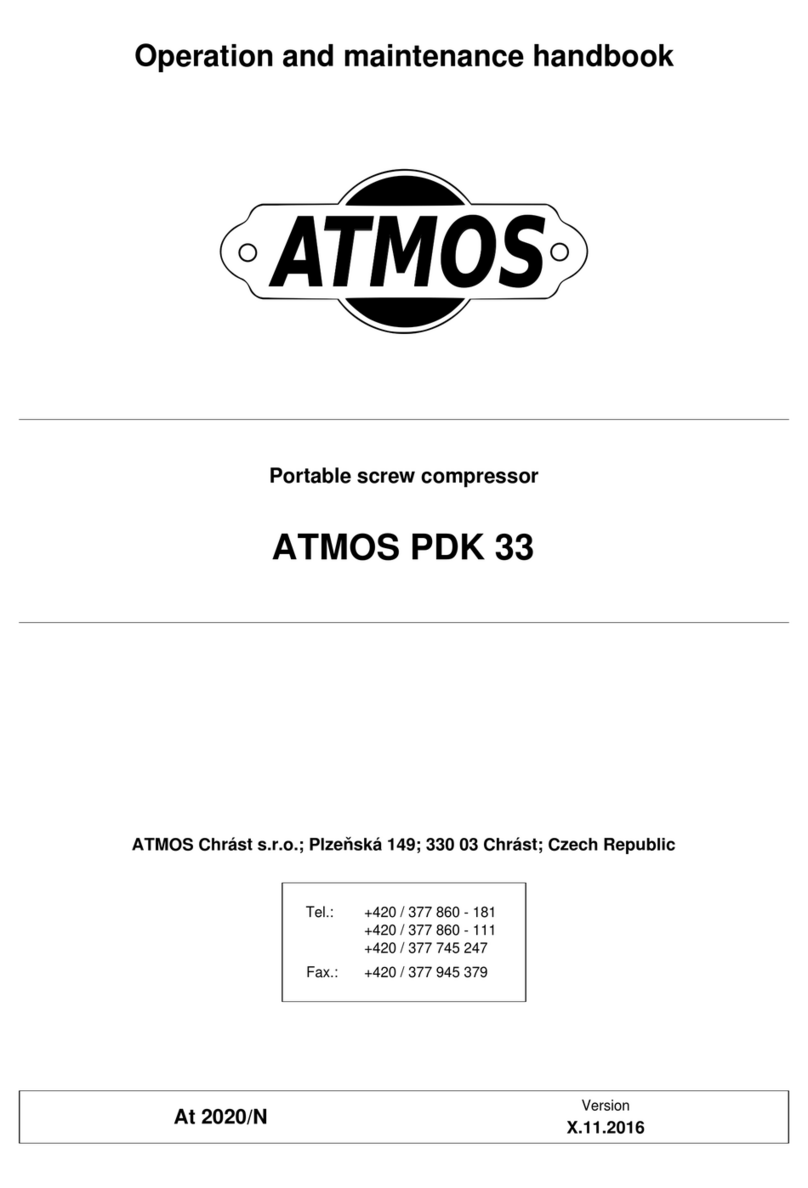
Atmos
Atmos PDK 33 Series Operation and Maintenance Handbook

Ingersoll-Rand
Ingersoll-Rand NIRVANA IRN45K-CC Operation and maintenance manual
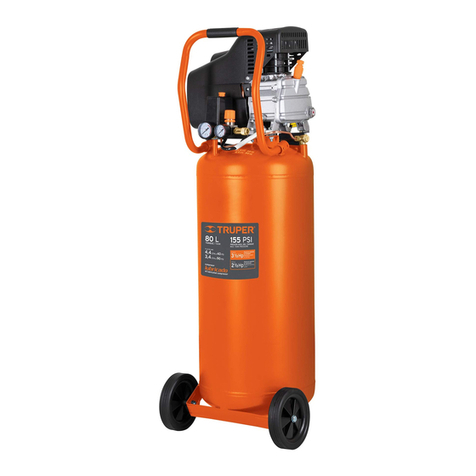
Truper
Truper COMP-80LV manual

GreenWorks Tools
GreenWorks Tools G40AC user manual

Ingersoll-Rand
Ingersoll-Rand Thermo King V-520 Series Maintenance manual
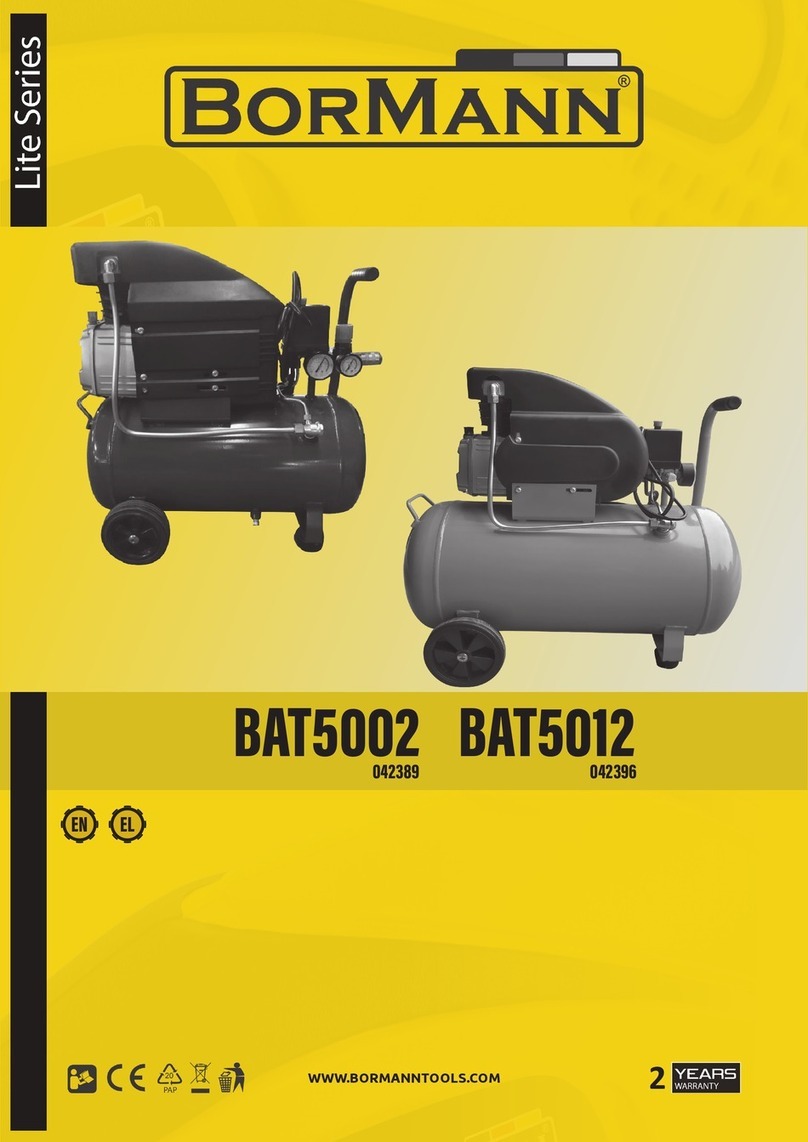
BorMann
BorMann Lite BAT5002 quick start guide
